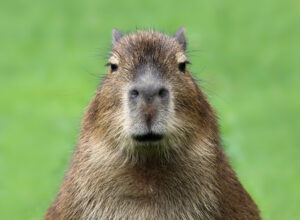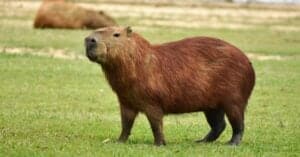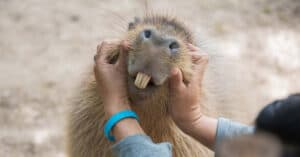Did you know that capybaras are the world’s largest rodents? These animals are members of the Hydrochoeridae family and are native to South America. The name “capybara” comes from the Tupi language and means “one who eats slender leaves.” These animals are related to guinea pigs and look somewhat like a cross between a pig, a squirrel, and a beaver. But how much do these guys weigh? Let’s find out!
How Much Do Capybaras Weigh?

The average weight of an adult male
capybara
is 70 to 120 pounds.
©Horus2017/Shutterstock.com
Capybaras are the largest rodents in the world, and they can weigh up to 150 pounds or more. That’s bigger than many decent-sized dogs! The average capybara is about two feet tall at the shoulder and four feet long from head to tail. Male capybaras are generally bigger than females.
The average weight of an adult male capybara is 70 to 120 pounds. However, some individuals can weigh as much as 150 pounds or more! Females tend to be smaller than males, with adult females generally weighing between 50 and 112 pounds.
How Much Do Baby Capybaras Weigh?
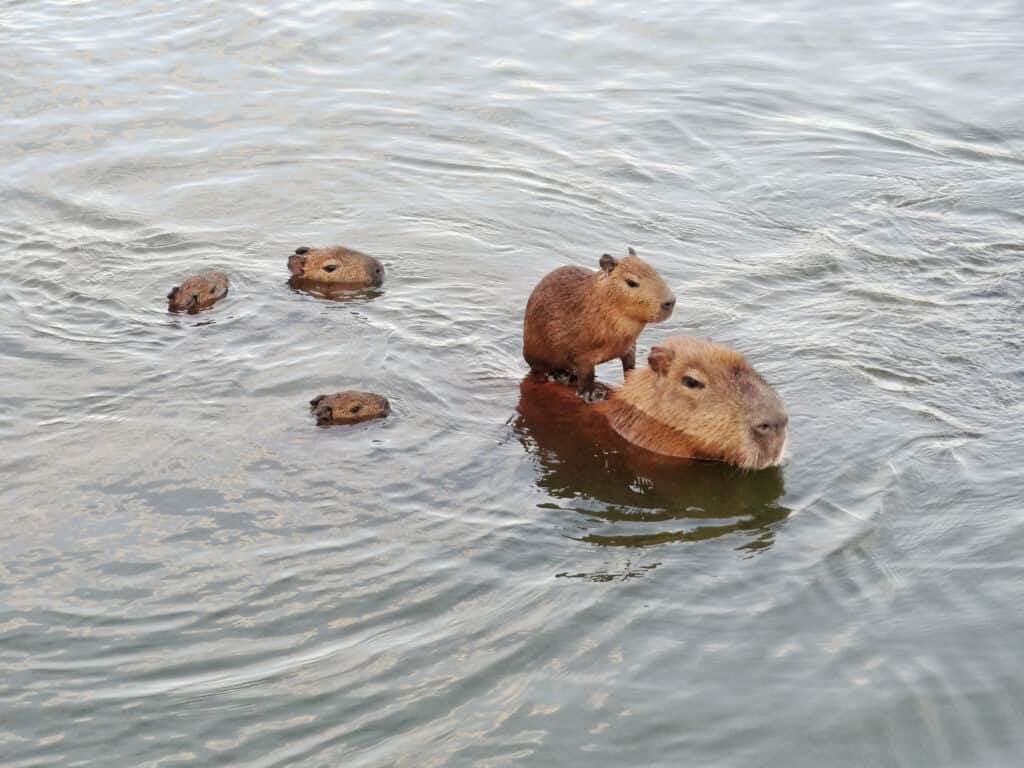
Baby capybaras are only two to four pounds when they are born.
©iStock.com/Yuina Takase
Interestingly, baby capybaras are born fully furred and can walk within hours of birth. Female capybaras usually give birth to three or four babies in a litter, although they can have up to seven or eight. A newborn capybara is very small, typically weighing between two and four pounds. They also begin eating solid food very early— a good thing since they grow quickly! By the time a baby capybara is 18 weeks old, it can weigh as much as 88 pounds.
Capybaras reach their full size by the time they’re 18 months old. That’s when they reach sexual maturity and can reproduce. Male capybaras usually weigh between 100 and 130 pounds at this time, while females typically weigh between 90 and 110 pounds.
Capybara size can vary quite a bit depending on the individual animal’s age, gender, and health. For example, an older or sick capybara is likely to weigh less than a younger, healthier one. In general, though, most capybaras fall within the weight range mentioned above.
These animals are native to South America, and they live in swampy areas near lakes and rivers. Capybaras are superb swimmers, and they’re often seen taking dips in the water to cool off. They’re also good climbers and have sharp claws that help them climb trees.
How Much Do Lesser Capybaras Weigh?
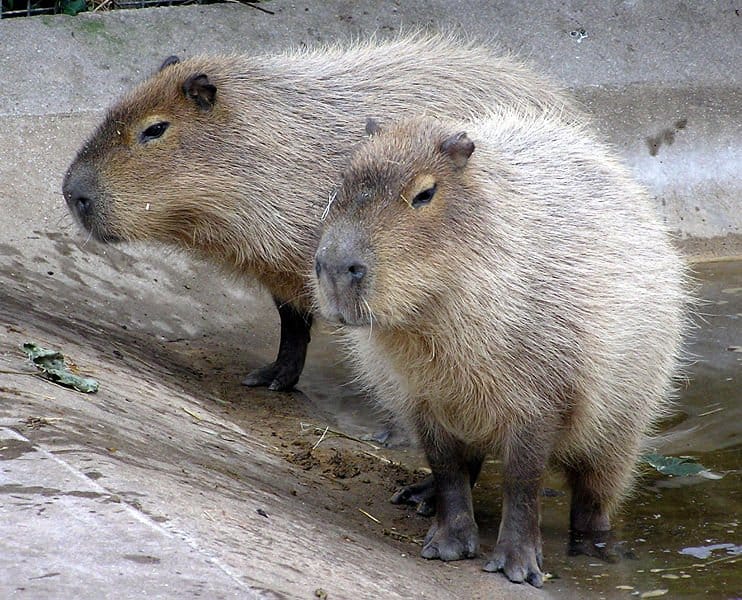
The lesser capybara is only found in Panama and
Colombia
and is the smaller of the two species of capybara.
©Arpingstone, Public domain, via Wikimedia Commons – License
There are actually two different species of capybaras in the world: the common capybara (Hydrochoerus hydrochaeris, discussed above) and the lesser capybara (Hydrochoerus isthmius). The lesser capybara is only found in Panama and Colombia and is the smaller of the two species of capybara. They only weigh a mere 60-80 pounds! That’s nearly half the size of their larger cousins. But how did these two animals come to have such radically different sizes?
It all comes down to diet. Both species of capybara are vegetarians, but the lesser capybara has a more restricted diet than its larger cousin. The lesser capybara mainly feeds on leaves, stems, and fruits, while the larger variety will also eat aquatic plants and even small turtles. This difference in diet is due to habitat; the lesser capybaras live in dry forests and don’t have access to the same water sources as their larger cousins.
Do Capybaras Make Good Pets?
Capybaras are so big that many people mistake them for being a member of the deer family! But don’t let their size fool you — these creatures are gentle giants with a sweet disposition. Although some people keep them as pets, capybaras can be difficult to care for in captivity, and have many unique needs and requirements.
How Weight Affects Care
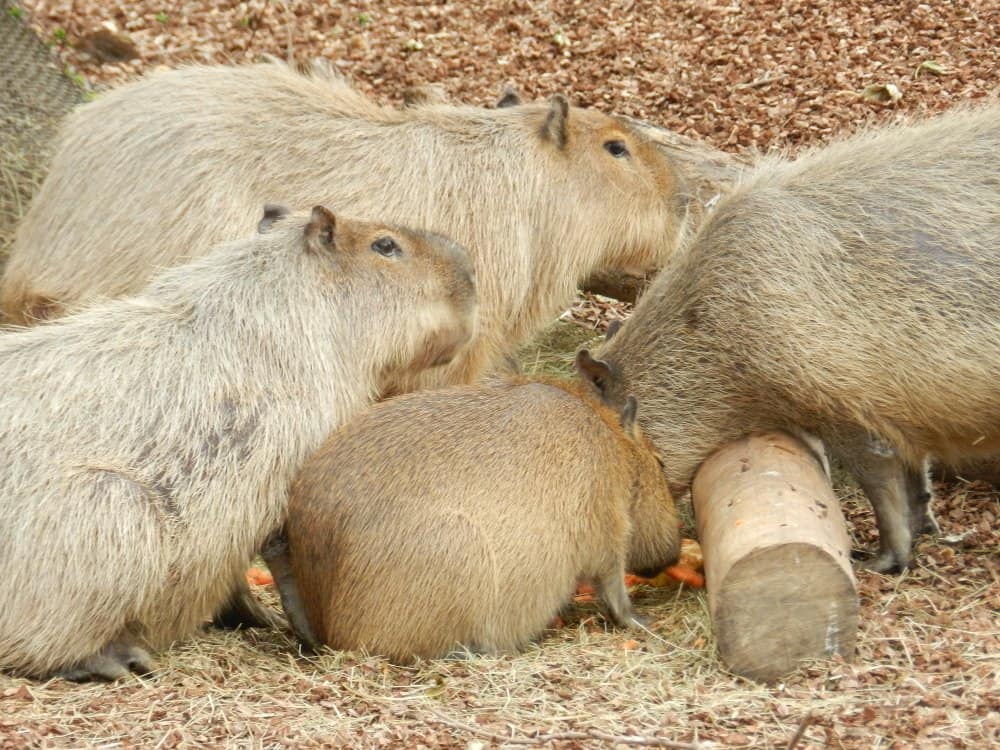
Capybaras are extremely social animals, so they need other capybaras with them.
©Millie Bond – Copyright A-Z Animals
Capybaras originated in South America, where they live near bodies of water in dense forest habitats. In captivity, however, they can adapt to a wide range of environments — provided their housing meets their specific needs. For example, as semi-aquatic mammals, capybaras need 24-hour access to a large pool or pond of water for swimming and bathing.
Capybaras are extremely social animals, so they need other capybaras with them. In the wild, they live in groups of 10-20 individuals, sometimes even more. This means that they will need a very large, protected enclosure — and larger is better. This gives them enough space to move around, play, and explore.
Capybaras also like to hide away in small spaces, so their enclosure should include hiding places like tunnels or dens. These places help them feel safe and secure and provide them with a place to escape from bright lights or loud noises.
In addition, capybaras eat a lot — around six to eight pounds of food or roughly three to four percent of their body weight each day. They are also very picky eaters and need high-quality grasses and aquatic plants. Capybaras love to graze and forage, so they need a lot of space just for eating. As rodents, their front teeth continuously grow, so they need to eat consistently to wear them down.
As the largest rodent in the world, capybaras can weigh up to 150 pounds or more — that’s a lot for a rodent! But don’t let their size fool you — these creatures are gentle giants that make great pets for people who have the space and resources to accommodate them. If you’re considering adopting a capybara, be sure to research its specific needs to provide it with the best possible care.
Up Next:
- Capybara Location: Where Do Capybaras Live?
- What Do Capybaras Eat? Their Diet Explained
- Capybara Teeth: Everything You Need to Know
- Do Capybaras Make Good Pets? Sweet Rodents with Special Needs
The photo featured at the top of this post is © BeautifulPicture/Shutterstock.com
Sources
- Rainforest Alliance, Available here: https://www.rainforest-alliance.org/species/capybara/
- CAPYBARAWORLD, Available here: https://capybaraworld.wordpress.com/category/capybara-management-in-captivity/
Thank you for reading! Have some feedback for us? Contact the AZ Animals editorial team.



